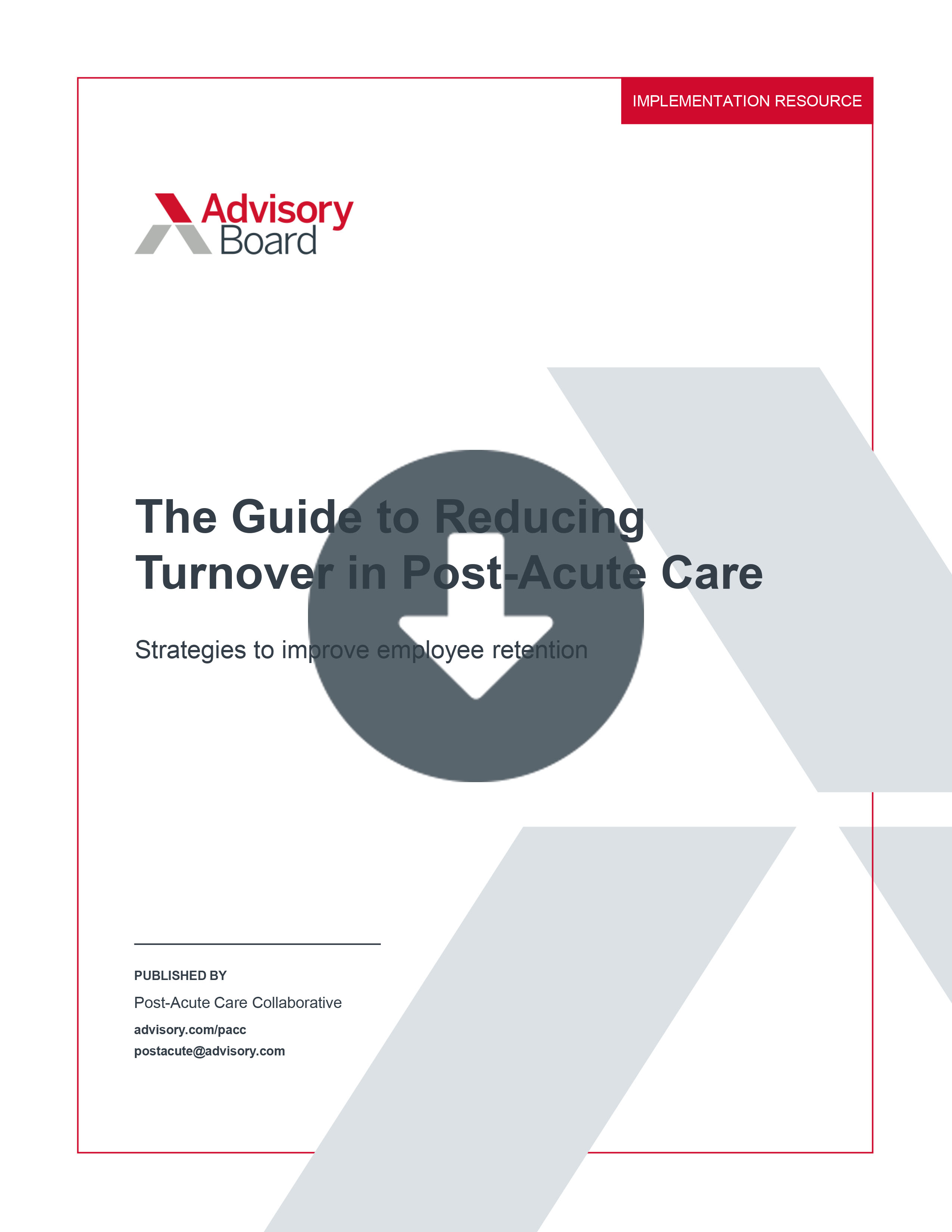Auto logout in seconds.
Continue LogoutAs providers face increasing transparency in the news and through publicly reported data, improving the patient and family experience is an even more critical strategy for winning volumes. This page, designed with post-acute providers’ specific needs in mind, has been built to help you transform the care experience throughout your organization.
- Set Organization-Specific Experience Goals
- Meet Minimum Service Standards
- Provide an Individual Experience
Step One: Set Organization-Specific Experience Goals
Any provider hoping to improve the patient and family experience must first define a clear vision and strategy for doing so and communicate it throughout their organization.
Involve patients and families in the feedback process.- Experience Advisory Council toolkit: Incorporate patient and family input into your goal-setting process using our four step toolkit.
- Post-Acute Leaders' Top Experience Commitments: Reference our summary document to learn what patient and family experience commitments other post-acute providers are making.
- Goal-Setting Worksheet: Use this worksheet with your team to create your own experience strategy. If you’d like our team to come on-site to help you define this strategy, please reach out to your dedicated advisor.
Step Two: Meet Minimum Service Standards
Regardless of institution-specific experience goals, there are certain baseline standards every post-acute provider must meet in order to provide a positive care experience to patients and families:
Manage patient and family expectations.- What to Expect from Post-Acute Care: Prior to discharge, provide patients and family members with a two-page guide explaining post-acute setting they're going to.
- HCF Management’s Constant Caring Program: Assign each patient a single staff member to serve as their main point of contact if issues arise.
- Tuck-in Calls: Proactively identify after-hours needs by checking in on high-need home health and hospice patients before the weekend.
- Family-Initiated Rapid Response Team: Use a call line to address and triage family members’ urgent requests when staff aren’t around.
- Workflow Modification Starter List: Use our list to learn about simple modifications you can make to avoid common disruptions to patient rest and routine.
- Identification Exercise: Then, complete this exercise to learn how to address disruptions unique to your organization.
Step Three: Provide an Individual Experience
Lastly, providers must incorporate patient and family member’s unique needs into their care and experience plans.Help patients and families express their unique care preferences…
- Patient Personalization Poster Templates Use our templates to let patients express their desired level of personal information and preferences to staff who enter their room.
- Jamesway Health's Patient Care Journal: Provide patients with a resource so they can express their needs to staff between visits.
- Managing Challenging Patient and Family Requests: Provide frontline staff with this handout to help them understand which patient and family requests to prioritize, and which requests may interfere with other organizational priorities.
- Ready-to-use Workshop: Schedule a workshop with your team to assess common patient and family requests and learn how to manage them. Or, reach out to your dedicated advisor for more information about having our team come on-site to facilitate a workshop for you.
The Guide to Reducing Staff Turnover in Post-Acute Care
Providing a positive care experience is even more difficult if staff are frequently turning over—a challenge many post-acute providers face. Learn more about how to recruit and retain the right staff for your organization.
Don't miss out on the latest Advisory Board insights
Create your free account to access 1 resource, including the latest research and webinars.
Want access without creating an account?
You have 1 free members-only resource remaining this month.
1 free members-only resources remaining
1 free members-only resources remaining
You've reached your limit of free insights
Become a member to access all of Advisory Board's resources, events, and experts
Never miss out on the latest innovative health care content tailored to you.
Benefits include:
You've reached your limit of free insights
Become a member to access all of Advisory Board's resources, events, and experts
Never miss out on the latest innovative health care content tailored to you.
Benefits include:
This content is available through your Curated Research partnership with Advisory Board. Click on ‘view this resource’ to read the full piece
Email ask@advisory.com to learn more
Click on ‘Become a Member’ to learn about the benefits of a Full-Access partnership with Advisory Board
Never miss out on the latest innovative health care content tailored to you.
Benefits Include:
This is for members only. Learn more.
Click on ‘Become a Member’ to learn about the benefits of a Full-Access partnership with Advisory Board
Never miss out on the latest innovative health care content tailored to you.

